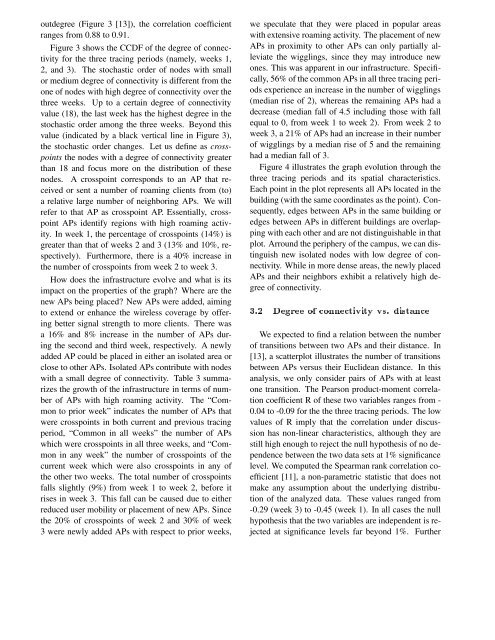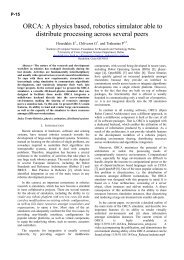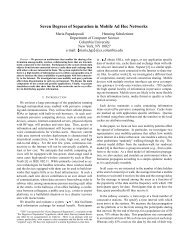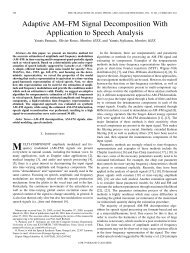Modeling Roaming in Large-scale Wireless Networks using Real ...
Modeling Roaming in Large-scale Wireless Networks using Real ...
Modeling Roaming in Large-scale Wireless Networks using Real ...
You also want an ePaper? Increase the reach of your titles
YUMPU automatically turns print PDFs into web optimized ePapers that Google loves.
outdegree (Figure 3 [13]), the correlation coefficient<br />
ranges from 0.88 to 0.91.<br />
Figure 3 shows the CCDF of the degree of connectivity<br />
for the three trac<strong>in</strong>g periods (namely, weeks 1,<br />
2, and 3). The stochastic order of nodes with small<br />
or medium degree of connectivity is different from the<br />
one of nodes with high degree of connectivity over the<br />
three weeks. Up to a certa<strong>in</strong> degree of connectivity<br />
value (18), the last week has the highest degree <strong>in</strong> the<br />
stochastic order among the three weeks. Beyond this<br />
value (<strong>in</strong>dicated by a black vertical l<strong>in</strong>e <strong>in</strong> Figure 3),<br />
the stochastic order changes. Let us def<strong>in</strong>e as crosspo<strong>in</strong>ts<br />
the nodes with a degree of connectivity greater<br />
than 18 and focus more on the distribution of these<br />
nodes. A crosspo<strong>in</strong>t corresponds to an AP that received<br />
or sent a number of roam<strong>in</strong>g clients from (to)<br />
a relative large number of neighbor<strong>in</strong>g APs. We will<br />
refer to that AP as crosspo<strong>in</strong>t AP. Essentially, crosspo<strong>in</strong>t<br />
APs identify regions with high roam<strong>in</strong>g activity.<br />
In week 1, the percentage of crosspo<strong>in</strong>ts (14%) is<br />
greater than that of weeks 2 and 3 (13% and 10%, respectively).<br />
Furthermore, there is a 40% <strong>in</strong>crease <strong>in</strong><br />
the number of crosspo<strong>in</strong>ts from week 2 to week 3.<br />
How does the <strong>in</strong>frastructure evolve and what is its<br />
impact on the properties of the graph? Where are the<br />
new APs be<strong>in</strong>g placed? New APs were added, aim<strong>in</strong>g<br />
to extend or enhance the wireless coverage by offer<strong>in</strong>g<br />
better signal strength to more clients. There was<br />
a 16% and 8% <strong>in</strong>crease <strong>in</strong> the number of APs dur<strong>in</strong>g<br />
the second and third week, respectively. A newly<br />
added AP could be placed <strong>in</strong> either an isolated area or<br />
close to other APs. Isolated APs contribute with nodes<br />
with a small degree of connectivity. Table 3 summarizes<br />
the growth of the <strong>in</strong>frastructure <strong>in</strong> terms of number<br />
of APs with high roam<strong>in</strong>g activity. The “Common<br />
to prior week” <strong>in</strong>dicates the number of APs that<br />
were crosspo<strong>in</strong>ts <strong>in</strong> both current and previous trac<strong>in</strong>g<br />
period, “Common <strong>in</strong> all weeks” the number of APs<br />
which were crosspo<strong>in</strong>ts <strong>in</strong> all three weeks, and “Common<br />
<strong>in</strong> any week” the number of crosspo<strong>in</strong>ts of the<br />
current week which were also crosspo<strong>in</strong>ts <strong>in</strong> any of<br />
the other two weeks. The total number of crosspo<strong>in</strong>ts<br />
falls slightly (9%) from week 1 to week 2, before it<br />
rises <strong>in</strong> week 3. This fall can be caused due to either<br />
reduced user mobility or placement of new APs. S<strong>in</strong>ce<br />
the 20% of crosspo<strong>in</strong>ts of week 2 and 30% of week<br />
3 were newly added APs with respect to prior weeks,<br />
we speculate that they were placed <strong>in</strong> popular areas<br />
with extensive roam<strong>in</strong>g activity. The placement of new<br />
APs <strong>in</strong> proximity to other APs can only partially alleviate<br />
the wiggl<strong>in</strong>gs, s<strong>in</strong>ce they may <strong>in</strong>troduce new<br />
ones. This was apparent <strong>in</strong> our <strong>in</strong>frastructure. Specifically,<br />
56% of the common APs <strong>in</strong> all three trac<strong>in</strong>g periods<br />
experience an <strong>in</strong>crease <strong>in</strong> the number of wiggl<strong>in</strong>gs<br />
(median rise of 2), whereas the rema<strong>in</strong><strong>in</strong>g APs had a<br />
decrease (median fall of 4.5 <strong>in</strong>clud<strong>in</strong>g those with fall<br />
equal to 0, from week 1 to week 2). From week 2 to<br />
week 3, a 21% of APs had an <strong>in</strong>crease <strong>in</strong> their number<br />
of wiggl<strong>in</strong>gs by a median rise of 5 and the rema<strong>in</strong><strong>in</strong>g<br />
had a median fall of 3.<br />
Figure 4 illustrates the graph evolution through the<br />
three trac<strong>in</strong>g periods and its spatial characteristics.<br />
Each po<strong>in</strong>t <strong>in</strong> the plot represents all APs located <strong>in</strong> the<br />
build<strong>in</strong>g (with the same coord<strong>in</strong>ates as the po<strong>in</strong>t). Consequently,<br />
edges between APs <strong>in</strong> the same build<strong>in</strong>g or<br />
edges between APs <strong>in</strong> different build<strong>in</strong>gs are overlapp<strong>in</strong>g<br />
with each other and are not dist<strong>in</strong>guishable <strong>in</strong> that<br />
plot. Arround the periphery of the campus, we can dist<strong>in</strong>guish<br />
new isolated nodes with low degree of connectivity.<br />
While <strong>in</strong> more dense areas, the newly placed<br />
APs and their neighbors exhibit a relatively high degree<br />
of connectivity.<br />
3.2 Degree of connectivity vs. distance<br />
We expected to f<strong>in</strong>d a relation between the number<br />
of transitions between two APs and their distance. In<br />
[13], a scatterplot illustrates the number of transitions<br />
between APs versus their Euclidean distance. In this<br />
analysis, we only consider pairs of APs with at least<br />
one transition. The Pearson product-moment correlation<br />
coefficient R of these two variables ranges from -<br />
0.04 to -0.09 for the the three trac<strong>in</strong>g periods. The low<br />
values of R imply that the correlation under discussion<br />
has non-l<strong>in</strong>ear characteristics, although they are<br />
still high enough to reject the null hypothesis of no dependence<br />
between the two data sets at 1% significance<br />
level. We computed the Spearman rank correlation coefficient<br />
[11], a non-parametric statistic that does not<br />
make any assumption about the underly<strong>in</strong>g distribution<br />
of the analyzed data. These values ranged from<br />
-0.29 (week 3) to -0.45 (week 1). In all cases the null<br />
hypothesis that the two variables are <strong>in</strong>dependent is rejected<br />
at significance levels far beyond 1%. Further
















